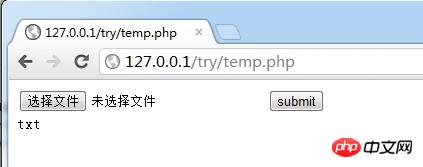PHP接受檔案並取得後綴名的方法
這篇文章主要介紹了使用PHP接受檔案並獲得其後綴名的方法,作者著重提到了其中$_FILES全局變數的使用,需要的朋友可以參考下
HTML的form表單
用html的表單模擬一個檔案上傳的post請求,程式碼如下:
<!DOCTYPE html>
<html>
<head>
<meta http-equiv="Content-Type" content="text/html; charset=UTF-8">
<title>File Upload</title>
</head>
<body>
<form enctype="multipart/form-data" action="test.php" method="POST">
<input type="hidden" name="MAX_FILE_SIZE" value="30000" />
Send this File:<input name="userfile" type="file"/>
<input type="submit" value="Send File" />
</form>
</body>
</html>
注意:
要確保檔案上傳表單的屬性是enctype="multipart/form- data",否則檔案上傳不了
PHP
首先,需要解釋一下PHP的全域變數$_FILES,此陣列包含了所有上傳的檔案資訊
#$_FILE['userfile']['name'] : 客戶端機器檔案的原名稱
$_FILE['userfile']['type'] : 檔案的MIME類型
$_FILE['userfile']['size'] : 已上傳的檔案大小
$_FILE['userfile' ]['tmpname'] : 檔案上傳後在伺服器儲存的暫存檔案名稱
#$_FILE['userfile']['error'] : 和該檔案上傳的錯誤代碼
想法
1、產生40位元的隨機字串作為檔案名稱
2、根據檔案是圖片還是語音轉存到不同的檔案位置
3、暫時不做檔案大小和檔案類型的校驗
function processFile($files, $type) {
$uploadName = null;
foreach ($files as $name => $value) {
$originalName = $value['name'];
$arr = explode(".", $originalName);
$postfix = $arr[count($arr) - 1];
$tmpPath = $value['tmp_name'];
$tmpType = $value['type'];
$tmpSize = $value['size'];
}
$newname = EhlStaticFunction::generateRandomStr(40).".".$postfix;
switch ($type) {
case 1 :
// 处理声音文件
$destination = VIDEOUPLOADDIR.$newname;
break;
case 2 :
// 处理图像文件
$destination = IMAGEUPLOADDIR.$newname;
break;
}
move_uploaded_file($tmpPath, $destination);
}而取得所上傳檔案的字尾名稱則可以使用一下程式碼:
HTML
<!DOCTYPE html PUBLIC "-//W3C//DTD XHTML 1.0 Transitional//EN" "http://www.w3.org/TR/xhtml1/DTD/xhtml1-transitional.dtd"> <html xmlns="http://www.w3.org/1999/xhtml"> <head> <meta http-equiv="Content-Type" content="text/html; charset=utf-8" /> <title></title> <meta name="keywords" content=" keywords" /> <meta name="description" content="description" /> </head> <body> <form method="post" action="" enctype="multipart/form-data"> <input type="file" name="upfile" size="20" /> <input type="submit" name="submit" value="submit" /> </form> </body> </html>
PHP
<?PHP
if(isset($_POST['submit'])) {
$string = strrev($_FILES['upfile']['name']);
$array = explode('.',$string);
echo $array[0];
}
?>結果範例:

#總結:以上就是這篇文章的全部內容,希望能對大家的學習有所幫助。
相關推薦:
PHP使用preg_split和explode實作分割textarea存放內容的方法
PHP實作基於Cookie設定使用者30分鐘未操作自動退出功能的方法
以上是PHP接受檔案並取得後綴名的方法的詳細內容。更多資訊請關注PHP中文網其他相關文章!

熱AI工具

Undresser.AI Undress
人工智慧驅動的應用程序,用於創建逼真的裸體照片

AI Clothes Remover
用於從照片中去除衣服的線上人工智慧工具。

Undress AI Tool
免費脫衣圖片

Clothoff.io
AI脫衣器

Video Face Swap
使用我們完全免費的人工智慧換臉工具,輕鬆在任何影片中換臉!

熱門文章

熱工具

記事本++7.3.1
好用且免費的程式碼編輯器

SublimeText3漢化版
中文版,非常好用

禪工作室 13.0.1
強大的PHP整合開發環境

Dreamweaver CS6
視覺化網頁開發工具

SublimeText3 Mac版
神級程式碼編輯軟體(SublimeText3)
 適用於 Ubuntu 和 Debian 的 PHP 8.4 安裝和升級指南
Dec 24, 2024 pm 04:42 PM
適用於 Ubuntu 和 Debian 的 PHP 8.4 安裝和升級指南
Dec 24, 2024 pm 04:42 PM
PHP 8.4 帶來了多項新功能、安全性改進和效能改進,同時棄用和刪除了大量功能。 本指南介紹如何在 Ubuntu、Debian 或其衍生版本上安裝 PHP 8.4 或升級到 PHP 8.4
 如何設定 Visual Studio Code (VS Code) 進行 PHP 開發
Dec 20, 2024 am 11:31 AM
如何設定 Visual Studio Code (VS Code) 進行 PHP 開發
Dec 20, 2024 am 11:31 AM
Visual Studio Code,也稱為 VS Code,是一個免費的原始碼編輯器 - 或整合開發環境 (IDE) - 可用於所有主要作業系統。 VS Code 擁有大量針對多種程式語言的擴展,可以輕鬆編寫
 在PHP API中說明JSON Web令牌(JWT)及其用例。
Apr 05, 2025 am 12:04 AM
在PHP API中說明JSON Web令牌(JWT)及其用例。
Apr 05, 2025 am 12:04 AM
JWT是一種基於JSON的開放標準,用於在各方之間安全地傳輸信息,主要用於身份驗證和信息交換。 1.JWT由Header、Payload和Signature三部分組成。 2.JWT的工作原理包括生成JWT、驗證JWT和解析Payload三個步驟。 3.在PHP中使用JWT進行身份驗證時,可以生成和驗證JWT,並在高級用法中包含用戶角色和權限信息。 4.常見錯誤包括簽名驗證失敗、令牌過期和Payload過大,調試技巧包括使用調試工具和日誌記錄。 5.性能優化和最佳實踐包括使用合適的簽名算法、合理設置有效期、
 解釋PHP中的晚期靜態綁定(靜態::)。
Apr 03, 2025 am 12:04 AM
解釋PHP中的晚期靜態綁定(靜態::)。
Apr 03, 2025 am 12:04 AM
靜態綁定(static::)在PHP中實現晚期靜態綁定(LSB),允許在靜態上下文中引用調用類而非定義類。 1)解析過程在運行時進行,2)在繼承關係中向上查找調用類,3)可能帶來性能開銷。
 您如何在PHP中解析和處理HTML/XML?
Feb 07, 2025 am 11:57 AM
您如何在PHP中解析和處理HTML/XML?
Feb 07, 2025 am 11:57 AM
本教程演示瞭如何使用PHP有效地處理XML文檔。 XML(可擴展的標記語言)是一種用於人類可讀性和機器解析的多功能文本標記語言。它通常用於數據存儲
 php程序在字符串中計數元音
Feb 07, 2025 pm 12:12 PM
php程序在字符串中計數元音
Feb 07, 2025 pm 12:12 PM
字符串是由字符組成的序列,包括字母、數字和符號。本教程將學習如何使用不同的方法在PHP中計算給定字符串中元音的數量。英語中的元音是a、e、i、o、u,它們可以是大寫或小寫。 什麼是元音? 元音是代表特定語音的字母字符。英語中共有五個元音,包括大寫和小寫: a, e, i, o, u 示例 1 輸入:字符串 = "Tutorialspoint" 輸出:6 解釋 字符串 "Tutorialspoint" 中的元音是 u、o、i、a、o、i。總共有 6 個元
 什麼是PHP魔術方法(__ -construct,__destruct,__call,__get,__ set等)並提供用例?
Apr 03, 2025 am 12:03 AM
什麼是PHP魔術方法(__ -construct,__destruct,__call,__get,__ set等)並提供用例?
Apr 03, 2025 am 12:03 AM
PHP的魔法方法有哪些? PHP的魔法方法包括:1.\_\_construct,用於初始化對象;2.\_\_destruct,用於清理資源;3.\_\_call,處理不存在的方法調用;4.\_\_get,實現動態屬性訪問;5.\_\_set,實現動態屬性設置。這些方法在特定情況下自動調用,提升代碼的靈活性和效率。
 PHP和Python:比較兩種流行的編程語言
Apr 14, 2025 am 12:13 AM
PHP和Python:比較兩種流行的編程語言
Apr 14, 2025 am 12:13 AM
PHP和Python各有優勢,選擇依據項目需求。 1.PHP適合web開發,尤其快速開發和維護網站。 2.Python適用於數據科學、機器學習和人工智能,語法簡潔,適合初學者。






